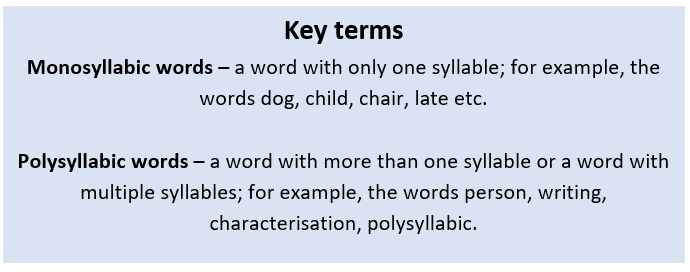The language can tell you a lot about the audience and the formality of a text. You should look at the type of words used in a text. For example, a text aimed at children will include mainly monosyllabic words, whereas a text aimed towards adults will include more polysyllabic words. A formal text will tend to include more polysyllabic words than monosyllabic. A text may also include dialect words or jargon (specialist words that are used in professional fields or groups that can be difficult for others to understand; for example, a text from the medical profession will include a lot of medical terminology that may be difficult to understand). The use of dialect words can tell you more about where the text was written, i.e. what region. The use of jargon can tell you a lot about the writer and the intended audience of a text.

Looking at the language of a text also involves analysing the literary devices that the writer has used and what effect they create – you should think about how the use of certain literary devices helps reinforce the effect, idea or viewpoint they are attempting to create. You must also look at what connotations the words or colours that have been used have. For example, a poster advertising a new hot sauce may include a lot of shades of red to connote how hot the sauce is.
A text written in the past and present tense can create different effects. The present tense is much more immediate and so is commonly used in advertising, whereas magazine and newspaper articles are written in the past tense as they are always commenting on events that have already occurred and what have already happened.
You should also consider the person that the text is written in. First person, second person and third person texts all create different effects. Second person is more commonly used in advertising texts. For example, a poster advertising an event might read ‘you won’t want to miss it’ which is a rhetorical device used to persuade an audience. Second person also tends to be more informal but you would also need to analyse the language in order to fully assess this.
Whenever you analyse something in a text you must always think about the reasons the writer may be using it. In the exam, you will be required to point out aspects of the writing and relate this to the purpose, audience, form and tone of a text. However, without providing evidence from the text itself (a quote for example) or an explanation as to what effect it creates and how it reinforces what the writer is trying to achieve, you will not gain any marks.
An important technique to use when making any point is the P E E structure, which stands for Point, Evidence, Explain. In each paragraph, you should make your point, provide evidence for you point (a quotation from the text) followed by an explanation of what effect it creates and why the writer may have chosen to use it.
In the next few chapters we will look at the different types of non-fiction texts in detail.



